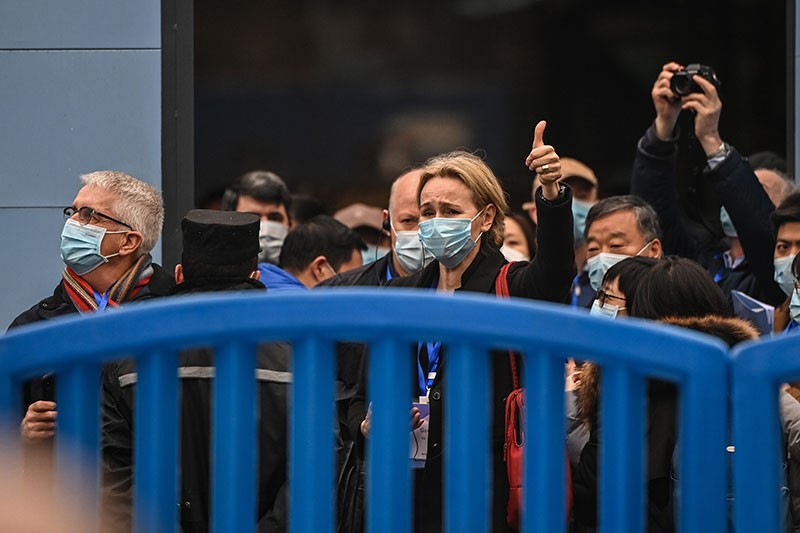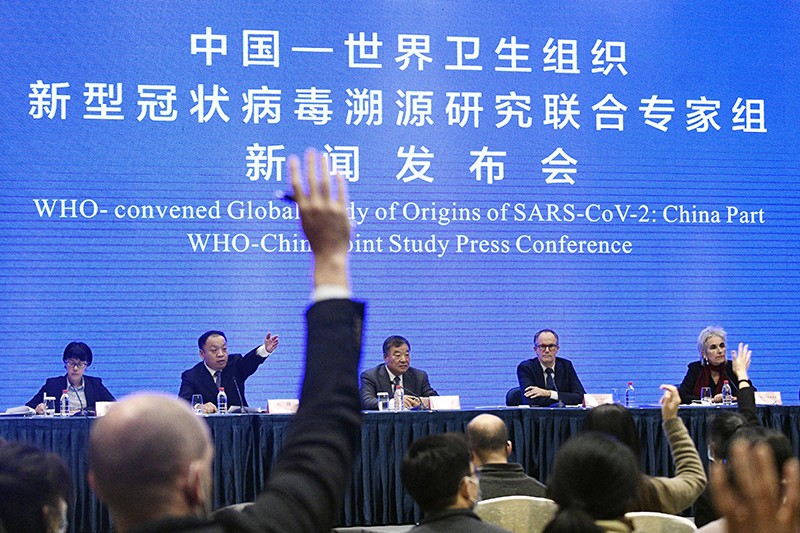Scientists say that the hunt for the COVID pandemic’s origins must continue, after a World Health Organization (WHO) team’s visit to China didn't find answers to key questions about how the coronavirus started infecting people.
At a press briefing on 9 February in Wuhan, China, members of the WHO team reported a series of conclusions from their month-long investigation in the country for the origin of the coronavirus, which was first reported as a mystery illness in December 2019. The researchers largely discounted the controversial theory that the virus accidentally leaked from a laboratory, and suggested that SARS-CoV-2 most likely first passed to people from an intermediate animal — already a leading hypothesis among researchers. But the team also offered two hypotheses promoted by the Chinese government: that it is possible that the virus, or its most recent ancestor, came from an animal outside China, and that once the virus was circulating in people it could have spread to others on frozen wildlife and other cold packaged goods. That theory has been heavily promoted by Chinese media.
Researchers have given a mixed assessment of the investigation’s findings. “There are still major stones that need to be unturned because any investigation into virus origins won’t be accomplished in two weeks,” says Angela Rasmussen, a virologist at Georgetown University who is based in Seattle, Washington. “But what’s important is that this lays the groundwork for a longer investigation in collaboration with the Chinese government,” she says.
Some researchers say that the team, which included 17 researchers from China and 17 international scientists, seems to have asked relevant questions and accessed large amounts of data. “It seems the WHO team and their Chinese collaborators are taking a measured approach, weighing the available data appropriately and talking to the right people,” says David Robertson, a virologist at the University of Glasgow, UK. Robertson says he hopes finer details will be published in the investigation report, which is expected soon.
Lab leak unlikely
But other scientists say that it’s not clear what evidence the team used to come to some of its conclusions. The findings don’t change the existing widely held view that the virus originated in animals, Nikolai Petrovsky, an immunologist at Flinders University in Adelaide, told the Australian Science Media Centre. And the assessment goes further than expected because it emphasizes the two hypotheses promoted by the Chinese government. Petrovsky says that is limited evidence for the idea that early transmission in China was linked to the ‘cold food chain’, the transportation of frozen goods such as meat, “beyond relatively weak data already in the public domain”. However, he acknowledges that the team might have access to information that is not currently public.
Dominic Dwyer, a medical virologist at New South Wales Health Pathology, in Sydney, and a member of the WHO team, says that there is some evidence to suggest that the coronavirus could have spread on contaminated fish and meat at Chinese markets, and more details will be included in the written report.
Another focus of the WHO’s investigation had been the idea that the virus had leaked from a lab — a scenario that the team says it found unlikely. Peter Ben Embarek, a food-safety scientist who heads the WHO mission, said that the team conducted extensive discussions with staff at the Wuhan Institute of Virology (WIV), which has been at the centre of that speculation, and other virology labs in Wuhan. He said a leak was unlikely also because the virus was not known to scientists before December 2019.
Dwyer says that the team didn’t see anything during its visits to suggest a lab accident. “Now, whether we were shown everything? You can never know. The group wasn’t designed to go and do a forensic examination of lab practice.”
The investigation provides more context and insight into what was happening in Wuhan, says Jason Kindrachuck, a microbiologist at the University of Manitoba. But the divide between the lab-leak and the ‘natural origins’ theory has grown deeper as the pandemic has progressed and become politicized, he says. “This isn’t going to put a nail in the coffin for the debate.”
First Wuhan cases
Much of the investigation centered on the early days of the outbreak in Wuhan — where cases of a ‘viral pneumonia’ were reported in December 2019 — and tried to pin down the timing of the city’s first infections. The WHO team reviewed health records in the city and the province for unusual fluctuations in influenza-like illnesses and severe respiratory infections, pharmacy purchases for cold and cough medications, and mortality and deaths specifically related to pneumonia in the second half of 2019. They also retrospectively tested some 4,500 patient samples for SARS-CoV-2 viral RNA, and analysed blood samples for antibodies against the virus. Based on these analyses, the researchers found no evidence that the virus was circulating in the city before December 2019.
But the lack of clear signals of transmission does not mean that the virus wasn’t already well-established in the community at that time, says Dwyer. The team’s analysis was based on limited data and a surveillance system that was not designed to catch a virus that could spread silently. To assess properly whether the virus arrived earlier than December, researchers would have to track what was happening in the wider community, not just in health facilities, he says.
And although the investigation team threw its weight behind the animal-origin theory, they didn’t identify the kind of animals that could have passed the virus to people. Ben Embarek said Chinese researchers had tested many domestic, farmed and wild animals in the country but found no evidence that the virus was present or continues to circulate in these species.
Petrovsky says that the animal-transmission findings could hold an important lesson: “If this pandemic was due to a natural transmission event then we can expect multiple further transmissions of similar related coronaviruses from the same animal host to humans over coming years.”
Further scrutiny
The WHO team said that investigations in Wuhan and nearby areas should continue, in particular trying to track down the earliest cases, which could help understand how the pandemic started. They recommended analysing older samples from blood banks in the province and other areas of interest, including using antibody tests that could turn up traces of infection.
The researchers also said that more studies were needed to better understand the possible role of frozen wildlife in viral transmission, and whether people can be infected through this route. More extensive testing of animals that could act as viral reservoirs is also needed, the group said.
“I’d like to hear more about plans for more work,” says Rasmussen. There are supposedly virus samples stored in the labs that haven’t been sequenced, but that requires planning and money, she says.
Scientists say the WHO team’s advice to broaden the search for the virus origin beyond China is justified, especially given fresh reports of coronaviruses closely related to SARS-CoV-2 found in bats in Japan, Cambodia and Thailand.
In a study published in Nature Communications on 9 February, scientists report finding a new coronavirus, which they’ve named RacCS203, in bats (Rhinolophus acuminatus) captured in a cave in eastern Thailand in June. The virus shares 91.5% of its genome with SARS-CoV-2. Although it is not the closest known relative to the pandemic virus, the finding shows that closely related viruses are currently circulating in southeast Asia. “Without any doubt if I had only one chance to survey now, I would survey in southeast Asia rather than inside China,” says Linfa Wang, a virologist at Duke–National University of Singapore Medical School, who led the work.
Researchers have identified several other coronaviruses closely related to the pandemic virus in frozen bat samples stored in Cambodia and Japan. They have also extensively sampled bats in China over the past 15 years. That has helped to identify the closest known virus relative to SARS-CoV-2, named RaTG13, in a species called intermediate horseshoe bats (Rhinolophus affinis). The two viruses share 96% of their genomes. “If we put the same effort and money and the same talent into southeast Asia, we may get more closely related viruses,” says Wang.
"who" - Google News
February 10, 2021 at 10:22PM
https://ift.tt/3p8IUiQ
COVID origin search must continue after WHO report, say scientists - Nature.com
"who" - Google News
https://ift.tt/36dvnyn
https://ift.tt/35spnC7
Bagikan Berita Ini
















0 Response to "COVID origin search must continue after WHO report, say scientists - Nature.com"
Post a Comment